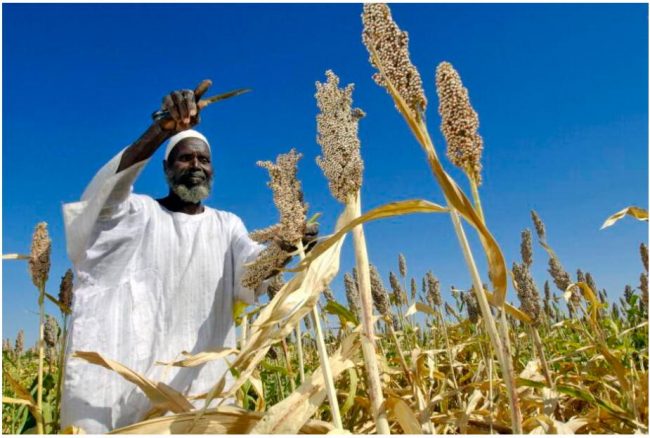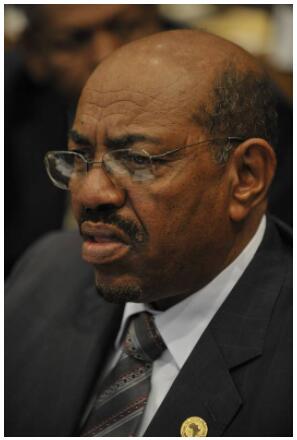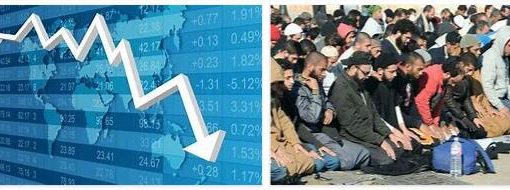Economic structure
The economy of Sudan is characterized by agriculture and oil production. The country had experienced an economic boom since the end of the 1990’s due to the income from the oil sector, but only the capital region benefited from this and the peripheral regions remained excluded from economic development. After the South split off, Sudan had to do without 75% of its oil fields and has since been gripped by a deep economic crisis, with an inflation rate of over 50% in 2019. For 2020, it is assumed that over 60%.
In addition to the remaining oil production, agriculture, in which a third of the GDP is generated, with the main export products cotton and gum arabic, in which Sudan is the world market leader, and the mining sector, with the extraction of gold, magnesium, iron, marble and uranium, the main industries.
Since the loss of most of the oil fields, the government has tried to diversify the stagnating economy more. Gold mining in particular has experienced a real boom in recent years. In 2015 Sudan rose to become the third largest gold producer in Africa after Ghana and South Africa. Gold mining repeatedly leads to land conflicts and to a very large extent takes place with the simplest methods under catastrophic security conditions.
According to ethnicityology, financially, Sudan is dependent on the transit fees for South Sudanese oil through its pipeline to Port Sudan. The fees for this are set at the equivalent of a comparatively high € 22.50 per barrel.
Sudan is also trying to strengthen its role as a transit country by expanding the trunk road connections to its important port, especially to inland Ethiopia.
The People’s Republic of China is Sudan’s most important investor and trading partner. About 6 to 8 percent of Beijing’s total oil imports come from Sudan, and about a third of Sudan’s oil is exported to China. With the help of Chinese companies, the highway connections and a new major airport in Omdurman are being built. The largest hydro-electric power project was built on the Nile near Hamdab 350 km north of Khartoum. The Merowe High Dam – also known as Hamdab Dam – is primarily intended for the production of electricity. The construction work was completed in 2008.
Economic sectors
Agriculture
In the agriculture of the Sudan is about 70% of the labor force, mostly in subsistence farming, busy. In the country, agriculture is only practiced on the banks of the Nile or in irrigation. Rain-fed agriculture is only possible in a few areas of the southern parts of the country. Millet (sorghum) and wheat are mainly grown for personal use, while cotton, peanuts and sesame are important export products. Recurring periods of drought are a major risk factor and cause immense crop failures.
The export products are grown in various irrigation projects, above all in the almost 9000 km² Gezira project southeast of Khartoum. This largest irrigation project in sub-Saharan Africa was laid out by the British during colonial times and was then considered a breadbasket for the Arab countries. The Gezira project uses the water of the Blue Nile through a huge canal system, which is diverted to the Gezira plain.
Since the beginning of the millennium, Sudan has gone over to leasing state arable land on a large scale to mostly Arab investors. This “land grabbing” leads to the displacement of small farmers and a decline in agricultural production for the local market.
The export product gum arabic is a specialty. It is obtained from the resin of two types of acacia that thrive in the so-called Gum Belt, which stretches from Senegal to Somalia. Gum arabic is used in many products in the food and pharmaceutical industries, but it used to be used in the printing industry, for example. According to estimates, Sudan is the undisputed world market leader with a market share of up to 85% and produces with hashab also the highest quality and most versatile variety. The main acacia growing areas are in Kordofan and Darfur. The importance of gum arabic is also evident from the fact that this raw material (at least unofficially) was never affected by the sanctions imposed by the economic embargo on Sudan. Since this raw material is also indispensable for soft drinks such as cola, the Washington Post disparagingly described the Achilles’ heel of the US embargo policy as “lemonade diplomacy”.
Pastoralism
Since the climatic conditions and soil conditions in Sudan allow agricultural use only a small part of the country, the extensive grazing livestock here ecologically best adapted form of economy. With the pastoral economy is in Sudan about 60% of agricultural economic output rendered and made a significant contribution to the country’s export volume.
In the dry desert and semi-desert areas, the country’s nomadic peoples have been traveling mainly with camels, in wetter areas also with cattle, goats and sheep, for centuries in the cycle of the seasons through Sudan. Conflicts with sedentary farmers, which has always existed, have worsened in the last few decades with changes in climatic conditions and advancing desertification. These ecological reasons are seen as one of the triggers for the Darfur conflict. A further problem arises with the large-scale “land grabbing”, in that the leasing of formerly state land opposes the transhumant migration movements of the nomads.




